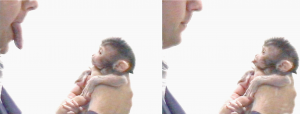Neurophysiological evidence supports the theory that gestural communication serves as the precursor of human language. Fogassi & Ferrari (2014) investigated the motor cortex in monkeys, also known as area F5, where mirror neurons are located. These mirror neurons are activated when an animal executes or observes a goal-related action performed by another. According to Skoyles (2000), mirror neurons are able to explain how signs are produced and interpreted. Mirror neurons are also able to support the emergence of spoken language after the demise of the primitive gesturing systems as a means of communication.
According to research done by Gallese et al. (1996) and Rizzolatti et al. (1996), these visuomotor neurons (mirror neurons) became activated in the area F5 of the brain when monkeys perform hand actions, or when they observe another individual producing a similar action.
There are two categories that depict the connection between mirror neurons and communication.
- Audiovisual mirror neurons becomes activated when monkeys not only observe, but also hear the sound of an action (Kolher et al, 2002)
- For example, a monkey would respond to the sound of a peanut being broken open when the action is either observed, heard, or both. However, a monkey would not respond to the vision or sound of another irrelevant action.
- Mouth mirror neurons become activated when a monkey observes and executes mouth ingestive actions such as biting, sucking, licking etc.
- For example, a monkey would respond and react in the presence of food or in anticipation of food.
The activation of the mirror neurons seems to have a direct correlation to the seen and produced actions. Hence, there is a possible impact on the interpretation of actions by action observation and execution.

Monkey See, Monkey Do? Fogassi et al. has revealed that mirror neurons in monkeys’ brains are activated when observing and executing both hand and mouth actions, suggesting its responsibility for the emergence of speech during evolution. (Image source)
Fogassi et al. (2004) suggests that the properties of mirror neurons are part of the basic neural mechanism that associates gestures with meaningful sounds. This also suggests that this pre-adaptation subsequently led to an emergence of speech.
In that case, how do mirror neurons link to the emergence of language in humans?
Skoyles (2000) explains that mirror neurons are found in an area known as area 44, located in the Broca’s area. Broca’s area is a region in the frontal lobe of the left hemisphere of the brain, responsible for language processing and speech production. Both area F5 and Broca’s area were activated during the observation of hand and mouth actions based on demonstrations by brain imaging experiments. With this homology of area 44 near Broca’s area and F5 region (where mirror neurons in monkeys were located), Fogassi & Ferrari (2004) proves the existence of a mirror system for action understanding, just like the activation of mirror neurons in monkeys.

Homology of area 44 in humans (left) and F5 region in a monkey’s brain shows that humans have a mirror system of understanding based on action observation and executive, similar to that of the dyadic communication in monkeys.
These observations in the cortical region precursor of Broca’s area, area 44, revealed its capacity to execute and understand hand and mouth actions, indicating primitive forms of dyadic communication (Fogassi & Ferrari, 2004). These homologies found based on neurophysiological evidence supports the gestures-first hypothesis – that human language evolved from a gesture performance and understanding system implemented a mirror neurons, allowing language to encompass features such as action-understanding, imitation-learning, and simulation of others’ behaviors as communication evolved over time.

